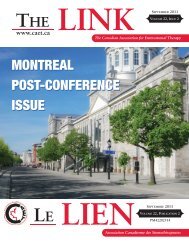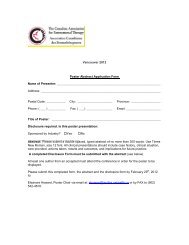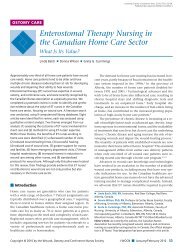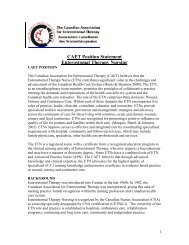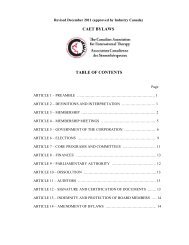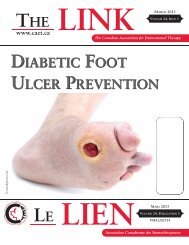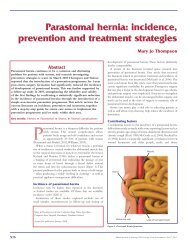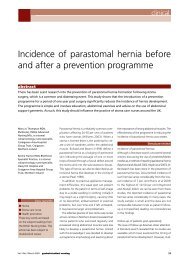Prevention of parastomal hernia: a comparison of results 3 years on
Prevention of parastomal hernia: a comparison of results 3 years on
Prevention of parastomal hernia: a comparison of results 3 years on
You also want an ePaper? Increase the reach of your titles
YUMPU automatically turns print PDFs into web optimized ePapers that Google loves.
clinical<br />
<str<strong>on</strong>g>Preventi<strong>on</strong></str<strong>on</strong>g> <str<strong>on</strong>g>of</str<strong>on</strong>g> <str<strong>on</strong>g>parastomal</str<strong>on</strong>g> <str<strong>on</strong>g>hernia</str<strong>on</strong>g>:<br />
a <str<strong>on</strong>g>comparis<strong>on</strong></str<strong>on</strong>g> <str<strong>on</strong>g>of</str<strong>on</strong>g> <str<strong>on</strong>g>results</str<strong>on</strong>g> 3 <str<strong>on</strong>g>years</str<strong>on</strong>g> <strong>on</strong><br />
Abstract<br />
Parastomal <str<strong>on</strong>g>hernia</str<strong>on</strong>g> c<strong>on</strong>tinues to be a comm<strong>on</strong> and distressing problem for patients with stomas and<br />
research investigating preventi<strong>on</strong> strategies is scant. In March 2005 Thomps<strong>on</strong> and Trainor reported that<br />
the introducti<strong>on</strong> <str<strong>on</strong>g>of</str<strong>on</strong>g> a preventi<strong>on</strong> programme for 1 year following stoma formati<strong>on</strong> surgery significantly<br />
reduced the incidence <str<strong>on</strong>g>of</str<strong>on</strong>g> <str<strong>on</strong>g>parastomal</str<strong>on</strong>g> <str<strong>on</strong>g>hernia</str<strong>on</strong>g>. This follow-up study strengthens the reliability and validity<br />
<str<strong>on</strong>g>of</str<strong>on</strong>g> the findings <str<strong>on</strong>g>of</str<strong>on</strong>g> the first study by c<strong>on</strong>firming a statistically significant reducti<strong>on</strong> in the incidence <str<strong>on</strong>g>of</str<strong>on</strong>g><br />
<str<strong>on</strong>g>parastomal</str<strong>on</strong>g> <str<strong>on</strong>g>hernia</str<strong>on</strong>g>s through the introducti<strong>on</strong> <str<strong>on</strong>g>of</str<strong>on</strong>g> a simple n<strong>on</strong>-invasive preventi<strong>on</strong> programme.<br />
Mary Jo Thomps<strong>on</strong> is<br />
Stoma/Coloproctology Nurse<br />
Specialist, Craigav<strong>on</strong> Area<br />
Hospital Group Trust, Northern<br />
Ireland, and Bernie Trainor is<br />
Stoma/Coloproctology Nurse<br />
Specialist, Daisy Hill Hospital<br />
and Craigav<strong>on</strong> Area Hospital<br />
Group Trust, Northern Ireland<br />
Key words<br />
■ Parastomal Hernia<br />
■ Stoma care nurse<br />
■ Stoma<br />
■ <str<strong>on</strong>g>Preventi<strong>on</strong></str<strong>on</strong>g><br />
strategies<br />
This article has been subject<br />
to double-blind peer review<br />
Parastomal <str<strong>on</strong>g>hernia</str<strong>on</strong>g> remains a comm<strong>on</strong> complicati<strong>on</strong><br />
<str<strong>on</strong>g>of</str<strong>on</strong>g> stoma surgery, occurring in 10–50% <str<strong>on</strong>g>of</str<strong>on</strong>g> patients<br />
(Raym<strong>on</strong>d and Abulafi, 2002; Williams, 2003).<br />
Rolstad and Boarini (1996) define a <str<strong>on</strong>g>parastomal</str<strong>on</strong>g><br />
<str<strong>on</strong>g>hernia</str<strong>on</strong>g> as a bulging <str<strong>on</strong>g>of</str<strong>on</strong>g> <str<strong>on</strong>g>parastomal</str<strong>on</strong>g> skin, indicating<br />
the passage <str<strong>on</strong>g>of</str<strong>on</strong>g> <strong>on</strong>e or more loops <str<strong>on</strong>g>of</str<strong>on</strong>g> bowel through<br />
a fascial defect around the stoma and into the<br />
subcutaneous tissues. A potential area <str<strong>on</strong>g>of</str<strong>on</strong>g> weakness<br />
within the abdominal muscle is created when a<br />
stoma is formed, and this can present problems<br />
for the patient in terms <str<strong>on</strong>g>of</str<strong>on</strong>g> self-image and difficulty<br />
in managing the practical appliances .<br />
Literature review<br />
A literature review undertaken for the initial<br />
study (Thomps<strong>on</strong> and Trainor, 2005) revealed<br />
that there had been little research into the<br />
preventi<strong>on</strong> <str<strong>on</strong>g>of</str<strong>on</strong>g> <str<strong>on</strong>g>parastomal</str<strong>on</strong>g> <str<strong>on</strong>g>hernia</str<strong>on</strong>g>s. A sec<strong>on</strong>d<br />
review <str<strong>on</strong>g>of</str<strong>on</strong>g> the literature carried out 3 <str<strong>on</strong>g>years</str<strong>on</strong>g> <strong>on</strong><br />
for the follow-up study found there had been<br />
no further research specifically <strong>on</strong> preventi<strong>on</strong> <str<strong>on</strong>g>of</str<strong>on</strong>g><br />
<str<strong>on</strong>g>parastomal</str<strong>on</strong>g> <str<strong>on</strong>g>hernia</str<strong>on</strong>g>ti<strong>on</strong>; however, <strong>on</strong>e review <str<strong>on</strong>g>of</str<strong>on</strong>g> the<br />
informati<strong>on</strong> available <strong>on</strong> incidence, treatment and<br />
preventi<strong>on</strong> <str<strong>on</strong>g>of</str<strong>on</strong>g> <str<strong>on</strong>g>parastomal</str<strong>on</strong>g> <str<strong>on</strong>g>hernia</str<strong>on</strong>g>s was uncovered<br />
(McGrath et al, 2006).<br />
McGrath et al (2006) found that the incidence<br />
<str<strong>on</strong>g>of</str<strong>on</strong>g> <str<strong>on</strong>g>parastomal</str<strong>on</strong>g> <str<strong>on</strong>g>hernia</str<strong>on</strong>g> varied according to the type<br />
<str<strong>on</strong>g>of</str<strong>on</strong>g> stoma formed. Reported rates <str<strong>on</strong>g>of</str<strong>on</strong>g> development<br />
<str<strong>on</strong>g>of</str<strong>on</strong>g> <str<strong>on</strong>g>parastomal</str<strong>on</strong>g> <str<strong>on</strong>g>hernia</str<strong>on</strong>g> in the literature varied<br />
widely: Harris et al (2003) reported the lowest<br />
incidence at 7% (n=354); Lala et al (2002) and<br />
Arumugam et al (2003) both reported rates<br />
<str<strong>on</strong>g>of</str<strong>on</strong>g> 16% (n=55 and n=97, respectively); and<br />
Pringle and Swan (2001) reported a rate <str<strong>on</strong>g>of</str<strong>on</strong>g> 20%<br />
(n=112). Raym<strong>on</strong>d and Abulafi (2002) reported<br />
an incidence <str<strong>on</strong>g>of</str<strong>on</strong>g> 10–50%. Limitati<strong>on</strong>s <str<strong>on</strong>g>of</str<strong>on</strong>g> these<br />
22 gastrointestinal nursing vol 5 no 3 April 2007
clinical<br />
studies included small samples and inc<strong>on</strong>sistencies<br />
in follow-up and documentati<strong>on</strong> <str<strong>on</strong>g>of</str<strong>on</strong>g> the time <str<strong>on</strong>g>of</str<strong>on</strong>g><br />
development <str<strong>on</strong>g>of</str<strong>on</strong>g> <str<strong>on</strong>g>parastomal</str<strong>on</strong>g> <str<strong>on</strong>g>hernia</str<strong>on</strong>g>, all <str<strong>on</strong>g>of</str<strong>on</strong>g> which<br />
hinder <str<strong>on</strong>g>comparis<strong>on</strong></str<strong>on</strong>g> <str<strong>on</strong>g>of</str<strong>on</strong>g> <str<strong>on</strong>g>results</str<strong>on</strong>g>.<br />
Follow-up <str<strong>on</strong>g>of</str<strong>on</strong>g> stoma patients postoperatively is<br />
poorly documented with regard to the time <str<strong>on</strong>g>of</str<strong>on</strong>g><br />
development <str<strong>on</strong>g>of</str<strong>on</strong>g> <str<strong>on</strong>g>parastomal</str<strong>on</strong>g> <str<strong>on</strong>g>hernia</str<strong>on</strong>g>s. Akman (1962)<br />
reported that 67.8% <str<strong>on</strong>g>of</str<strong>on</strong>g> incisi<strong>on</strong>al <str<strong>on</strong>g>hernia</str<strong>on</strong>g>s (n=500)<br />
had developed within 1 year postoperatively.<br />
Bucknall et al (1982) found that 57% <str<strong>on</strong>g>of</str<strong>on</strong>g> abdominal<br />
incisi<strong>on</strong>al <str<strong>on</strong>g>hernia</str<strong>on</strong>g>s (n=84) had developed within<br />
3 m<strong>on</strong>ths surgery.<br />
Factors c<strong>on</strong>tributing to the development <str<strong>on</strong>g>of</str<strong>on</strong>g><br />
<str<strong>on</strong>g>parastomal</str<strong>on</strong>g> <str<strong>on</strong>g>hernia</str<strong>on</strong>g> reported in the literature are<br />
obesity, sex, age, site <str<strong>on</strong>g>of</str<strong>on</strong>g> the stoma, abdominal<br />
distensi<strong>on</strong> and chr<strong>on</strong>ic cough (Pearl, 1989;<br />
McGrath et al, 2006). The variables examined<br />
in this study differ. Bucknall and Ellis (1984)<br />
reported the c<strong>on</strong>tributing factors to be chest<br />
infecti<strong>on</strong>, wound sepsis, male sex and age 60+<br />
<str<strong>on</strong>g>years</str<strong>on</strong>g>. Bucknall et al (1982) found a statistically<br />
significant correlati<strong>on</strong> between wound <str<strong>on</strong>g>hernia</str<strong>on</strong>g>ti<strong>on</strong><br />
Figure 1. Abdominal exercises following stoma-forming surgery. (Reprinted with<br />
kind permissi<strong>on</strong> from Resp<strong>on</strong>d Plus)<br />
and the elderly, male sex and obese patients<br />
undergoing bowel surgery.<br />
Aim <str<strong>on</strong>g>of</str<strong>on</strong>g> the study<br />
The aim <str<strong>on</strong>g>of</str<strong>on</strong>g> this follow-up study was to ascertain<br />
the reliability <str<strong>on</strong>g>of</str<strong>on</strong>g> the preventi<strong>on</strong> programme carried<br />
out by Thomps<strong>on</strong> and Trainor (2005). Raised<br />
awareness <str<strong>on</strong>g>of</str<strong>on</strong>g> the potential for <str<strong>on</strong>g>parastomal</str<strong>on</strong>g> <str<strong>on</strong>g>hernia</str<strong>on</strong>g><br />
development, the introducti<strong>on</strong> and teaching <str<strong>on</strong>g>of</str<strong>on</strong>g><br />
abdominal exercises and advice to use support<br />
belts while undertaking heavy lifting or heavy<br />
work until 1 year post-surgery were assessed to<br />
ascertain their c<strong>on</strong>tinued effectiveness in minimizing<br />
the development <str<strong>on</strong>g>of</str<strong>on</strong>g> <str<strong>on</strong>g>parastomal</str<strong>on</strong>g> <str<strong>on</strong>g>hernia</str<strong>on</strong>g>.<br />
Method<br />
The follow-up analysis utilized year 1 data as<br />
the c<strong>on</strong>trol for <str<strong>on</strong>g>comparis<strong>on</strong></str<strong>on</strong>g> <str<strong>on</strong>g>of</str<strong>on</strong>g> the effectiveness<br />
<str<strong>on</strong>g>of</str<strong>on</strong>g> the programme as it was in the initial study<br />
(March 2005):<br />
Year 1: A retrospective study <str<strong>on</strong>g>of</str<strong>on</strong>g> patients who<br />
had a new stoma formed between August 2001<br />
and July 2002 to determine the incidence <str<strong>on</strong>g>of</str<strong>on</strong>g><br />
<str<strong>on</strong>g>parastomal</str<strong>on</strong>g> <str<strong>on</strong>g>hernia</str<strong>on</strong>g> formati<strong>on</strong>.<br />
Year 2: A prospective study <str<strong>on</strong>g>of</str<strong>on</strong>g> patients who<br />
had a new stoma formed between August 2002<br />
and July 2003 to determine the incidence <str<strong>on</strong>g>of</str<strong>on</strong>g><br />
<str<strong>on</strong>g>parastomal</str<strong>on</strong>g> <str<strong>on</strong>g>hernia</str<strong>on</strong>g> formati<strong>on</strong>. These patients<br />
received active educati<strong>on</strong> <strong>on</strong> abdominal exercises<br />
(Figure 1) and were encouraged to use support<br />
belts or girdles to minimize the risk <str<strong>on</strong>g>of</str<strong>on</strong>g> developing<br />
a <str<strong>on</strong>g>parastomal</str<strong>on</strong>g> <str<strong>on</strong>g>hernia</str<strong>on</strong>g>.<br />
Year 3: A prospective study <str<strong>on</strong>g>of</str<strong>on</strong>g> patients who<br />
had a new stoma formed between August 2003<br />
and July 2004 to determine the incidence <str<strong>on</strong>g>of</str<strong>on</strong>g><br />
<str<strong>on</strong>g>parastomal</str<strong>on</strong>g> <str<strong>on</strong>g>hernia</str<strong>on</strong>g> formati<strong>on</strong>. These patients<br />
received active educati<strong>on</strong> <strong>on</strong> abdominal exercises<br />
(Figure 1) and were encouraged to use support<br />
belts or girdles to minimize the risk <str<strong>on</strong>g>of</str<strong>on</strong>g> developing<br />
a <str<strong>on</strong>g>parastomal</str<strong>on</strong>g> <str<strong>on</strong>g>hernia</str<strong>on</strong>g>. This arm <str<strong>on</strong>g>of</str<strong>on</strong>g> the study<br />
was utilized to test the reliability <str<strong>on</strong>g>of</str<strong>on</strong>g> the <str<strong>on</strong>g>results</str<strong>on</strong>g><br />
obtained in year 2. Follow-up was carried out<br />
for <strong>on</strong>e year post-surgery.<br />
As in the initial study, c<strong>on</strong>venience sampling was<br />
used to facilitate the capture <str<strong>on</strong>g>of</str<strong>on</strong>g> all patients who<br />
underwent surgery for stoma formati<strong>on</strong> at the<br />
two centres involved in the study. This method <str<strong>on</strong>g>of</str<strong>on</strong>g><br />
sampling enabled the maximum number <str<strong>on</strong>g>of</str<strong>on</strong>g> patients<br />
possible to be recruited during the proposed<br />
timescale. Within year 1 (August 2001 to July<br />
24 gastrointestinal nursing vol 5 no 3 April 2007
clinical<br />
2002) 101 patients were recruited, <str<strong>on</strong>g>of</str<strong>on</strong>g> whom 14<br />
died, resulting in an overall sample <str<strong>on</strong>g>of</str<strong>on</strong>g> 87 for this<br />
year. Within year 2 (August 2002 to July 2003)<br />
138 patients were recruited, <str<strong>on</strong>g>of</str<strong>on</strong>g> whom 24 died,<br />
resulting in an overall sample <str<strong>on</strong>g>of</str<strong>on</strong>g> 114 for this year.<br />
Within year 3 (August 2003 to July 2004) 148<br />
patients were recruited, <str<strong>on</strong>g>of</str<strong>on</strong>g> whom 49 died within<br />
the 1-year follow-up and were therefore excluded,<br />
resulting in an overall sample <str<strong>on</strong>g>of</str<strong>on</strong>g> 99.<br />
The preventi<strong>on</strong> programme introduced in<br />
year 2 c<strong>on</strong>tinued to be used in year 3 and is<br />
outlined below:<br />
1. On discharge, patients were advised to avoid all<br />
heavy lifting for 3 m<strong>on</strong>ths following surgery.<br />
2. At 3 m<strong>on</strong>ths postoperatively:<br />
i. Patients were advised <str<strong>on</strong>g>of</str<strong>on</strong>g> the potential risk <str<strong>on</strong>g>of</str<strong>on</strong>g><br />
the development <str<strong>on</strong>g>of</str<strong>on</strong>g> <str<strong>on</strong>g>parastomal</str<strong>on</strong>g> <str<strong>on</strong>g>hernia</str<strong>on</strong>g>.<br />
ii. Abdominal exercises were taught and<br />
dem<strong>on</strong>strated to patients (Figure 1). Patients<br />
were advised to undertake these exercises<br />
daily until 1 year postoperatively.<br />
iii. Patients were measured and support belts<br />
or girdles were ordered. Patients were<br />
instructed and encouraged to wear these<br />
while lifting anything heavy or undertaking<br />
heavy work.<br />
3. Patients were m<strong>on</strong>itored for the incidence <str<strong>on</strong>g>of</str<strong>on</strong>g><br />
<str<strong>on</strong>g>parastomal</str<strong>on</strong>g> <str<strong>on</strong>g>hernia</str<strong>on</strong>g> for 1 year postoperatively<br />
at regular intervals (3, 6 and 12 m<strong>on</strong>ths).<br />
The above advice was reinforced at each<br />
clinic appointment.<br />
Results and discussi<strong>on</strong><br />
A total <str<strong>on</strong>g>of</str<strong>on</strong>g> 387 patients were recruited to the<br />
study over the 3-year period; 87 <str<strong>on</strong>g>of</str<strong>on</strong>g> these died,<br />
leaving 300 patients involved in the study. The<br />
Figure 2. Age distributi<strong>on</strong> <str<strong>on</strong>g>of</str<strong>on</strong>g> study participants over the 3-year period.<br />
age distributi<strong>on</strong> <str<strong>on</strong>g>of</str<strong>on</strong>g> these patients is shown in<br />
Figure 2. It can be seen that the modal age<br />
group for <str<strong>on</strong>g>years</str<strong>on</strong>g> 1, 2 and 3 is 61–80 <str<strong>on</strong>g>years</str<strong>on</strong>g> (n=51,<br />
59 and 53, respectively).<br />
The incidence <str<strong>on</strong>g>of</str<strong>on</strong>g> <str<strong>on</strong>g>parastomal</str<strong>on</strong>g> <str<strong>on</strong>g>hernia</str<strong>on</strong>g> in year 1<br />
was 28% (n=24) (Figure 3). This is similar to the<br />
rates reported in some <str<strong>on</strong>g>of</str<strong>on</strong>g> the previous studies,<br />
e.g. 20% (Pringle and Swan, 2001) and 10–50%<br />
(Raym<strong>on</strong>d and Abulafi, 2002).<br />
In year 2, following the introducti<strong>on</strong> <str<strong>on</strong>g>of</str<strong>on</strong>g> the<br />
preventi<strong>on</strong> programme, the incidence <str<strong>on</strong>g>of</str<strong>on</strong>g> <str<strong>on</strong>g>parastomal</str<strong>on</strong>g><br />
<str<strong>on</strong>g>hernia</str<strong>on</strong>g> dropped to 14% (n=16), rising to 17%<br />
(n=17) in year 3 at 12 m<strong>on</strong>ths postoperatively<br />
(Figure 3).<br />
Analysis <str<strong>on</strong>g>of</str<strong>on</strong>g> the <str<strong>on</strong>g>results</str<strong>on</strong>g> using chi-squared (P≤0.025)<br />
showed a significant difference between year<br />
1 <str<strong>on</strong>g>results</str<strong>on</strong>g> and year 2 <str<strong>on</strong>g>results</str<strong>on</strong>g>, but no significant<br />
difference between year 1 and year 3 <str<strong>on</strong>g>results</str<strong>on</strong>g>, which<br />
suggested unreliability <str<strong>on</strong>g>of</str<strong>on</strong>g> the findings. However,<br />
year 3 patients had been asked about compliance<br />
with the programme at each review appointment,<br />
and closer examinati<strong>on</strong> <str<strong>on</strong>g>of</str<strong>on</strong>g> the <str<strong>on</strong>g>results</str<strong>on</strong>g> revealed<br />
that seven <str<strong>on</strong>g>of</str<strong>on</strong>g> the patients reported not having<br />
undertaken the exercise programme or using<br />
support garments for heavy lifting/heavy work<br />
as instructed. When the revised figures for those<br />
following the programme (n=10) were analysed<br />
using chi-squared, a statistically significant difference<br />
between <str<strong>on</strong>g>years</str<strong>on</strong>g> 1 and 3 was found (P≤0.01). This<br />
finding thus reinforces the effectiveness <str<strong>on</strong>g>of</str<strong>on</strong>g> this<br />
programme in preventing <str<strong>on</strong>g>parastomal</str<strong>on</strong>g> <str<strong>on</strong>g>hernia</str<strong>on</strong>g>, and<br />
dem<strong>on</strong>strates reliability <str<strong>on</strong>g>of</str<strong>on</strong>g> the programme.<br />
Sec<strong>on</strong>d stage follow-up in May 2005<br />
In May 2005, all the patients involved in <str<strong>on</strong>g>years</str<strong>on</strong>g> 1<br />
and 2 <str<strong>on</strong>g>of</str<strong>on</strong>g> the study were reviewed again to find<br />
out whether any further patients had developed<br />
<str<strong>on</strong>g>parastomal</str<strong>on</strong>g> <str<strong>on</strong>g>hernia</str<strong>on</strong>g>.<br />
Year 1: The incidence <str<strong>on</strong>g>of</str<strong>on</strong>g> <str<strong>on</strong>g>parastomal</str<strong>on</strong>g> <str<strong>on</strong>g>hernia</str<strong>on</strong>g><br />
was 49% (n=75 patients; 26 deaths). The mean<br />
time from surgery was 41 m<strong>on</strong>ths.<br />
Year 2: The incidence <str<strong>on</strong>g>of</str<strong>on</strong>g> <str<strong>on</strong>g>parastomal</str<strong>on</strong>g> <str<strong>on</strong>g>hernia</str<strong>on</strong>g><br />
was 30% (n=91; 47 deaths). The mean time<br />
from surgery was 29 m<strong>on</strong>ths.<br />
When these figures were analysed using chisquared,<br />
the difference between the <str<strong>on</strong>g>years</str<strong>on</strong>g> was<br />
statistically significant. It is important to note that,<br />
because <str<strong>on</strong>g>of</str<strong>on</strong>g> the deaths, a l<strong>on</strong>gitudinal follow-up <str<strong>on</strong>g>of</str<strong>on</strong>g><br />
patients can potentially skew <str<strong>on</strong>g>results</str<strong>on</strong>g>, so these figures<br />
need to be interpreted with that in mind.<br />
26 gastrointestinal nursing vol 5 no 3 April 2007
Stoma type<br />
Analysis <str<strong>on</strong>g>of</str<strong>on</strong>g> stoma type in year 3 patients<br />
showed that there were more patients with<br />
colostomies (n=51) than with ileostomies (n=43)<br />
or urostomies (n=5).<br />
In the initial study, when the distributi<strong>on</strong> <str<strong>on</strong>g>of</str<strong>on</strong>g><br />
<str<strong>on</strong>g>parastomal</str<strong>on</strong>g> <str<strong>on</strong>g>hernia</str<strong>on</strong>g> was analysed according to<br />
stoma type, the differences were not statistical<br />
significant. This suggested that, irrespective <str<strong>on</strong>g>of</str<strong>on</strong>g> the<br />
type <str<strong>on</strong>g>of</str<strong>on</strong>g> stoma, all stoma patients had an equal risk<br />
<str<strong>on</strong>g>of</str<strong>on</strong>g> developing a <str<strong>on</strong>g>parastomal</str<strong>on</strong>g> <str<strong>on</strong>g>hernia</str<strong>on</strong>g>. However, when<br />
the figures for year 3 in the present study were<br />
analysed, it was found that 13 <str<strong>on</strong>g>of</str<strong>on</strong>g> 17 colostomy<br />
patients had developed a <str<strong>on</strong>g>parastomal</str<strong>on</strong>g> <str<strong>on</strong>g>hernia</str<strong>on</strong>g><br />
compared with <strong>on</strong>ly 4 <str<strong>on</strong>g>of</str<strong>on</strong>g> 17 ileostomy patients;<br />
chi-squared analysis showed these differences<br />
to be statistically significant (P≤0.01), indicating<br />
that there was a correlati<strong>on</strong> between stoma type<br />
and incidence <str<strong>on</strong>g>of</str<strong>on</strong>g> <str<strong>on</strong>g>hernia</str<strong>on</strong>g>ti<strong>on</strong>. Data from the initial<br />
study were therefore revisited and chi-squared<br />
tests were carried out individually for each year.<br />
This time statistically significant differences<br />
were found for each <str<strong>on</strong>g>of</str<strong>on</strong>g> the 3 <str<strong>on</strong>g>years</str<strong>on</strong>g>, reinforcing<br />
the suggesti<strong>on</strong> that patients with colostomies<br />
are more likely to develop a <str<strong>on</strong>g>parastomal</str<strong>on</strong>g> <str<strong>on</strong>g>hernia</str<strong>on</strong>g><br />
than patients with ileostomies and urostomies<br />
(Figure 4). These <str<strong>on</strong>g>results</str<strong>on</strong>g> support those <str<strong>on</strong>g>of</str<strong>on</strong>g> McGrath<br />
et al (2006) who, while reviewing the literature<br />
<strong>on</strong> risk factors for <str<strong>on</strong>g>parastomal</str<strong>on</strong>g> <str<strong>on</strong>g>hernia</str<strong>on</strong>g>ti<strong>on</strong>, found<br />
that the incidence <str<strong>on</strong>g>of</str<strong>on</strong>g> <str<strong>on</strong>g>parastomal</str<strong>on</strong>g> <str<strong>on</strong>g>hernia</str<strong>on</strong>g> varied<br />
with the type <str<strong>on</strong>g>of</str<strong>on</strong>g> stoma formed.<br />
When the distributi<strong>on</strong> <str<strong>on</strong>g>of</str<strong>on</strong>g> <str<strong>on</strong>g>parastomal</str<strong>on</strong>g> <str<strong>on</strong>g>hernia</str<strong>on</strong>g>s in<br />
<str<strong>on</strong>g>years</str<strong>on</strong>g> 1, 2 and 3 was analysed according to age <str<strong>on</strong>g>of</str<strong>on</strong>g><br />
the patients it was found that n<strong>on</strong>e <str<strong>on</strong>g>of</str<strong>on</strong>g> the patients<br />
aged 40 <str<strong>on</strong>g>years</str<strong>on</strong>g> or less developed a <str<strong>on</strong>g>parastomal</str<strong>on</strong>g> <str<strong>on</strong>g>hernia</str<strong>on</strong>g><br />
(Figure 5). A possible reas<strong>on</strong> for this may be that<br />
younger patients show better compliance with the<br />
programme or have more active lifestyles.<br />
The literature could be seen to support this<br />
finding, e.g. Bucknall and Ellis (1984) reported<br />
that age 60+ was a c<strong>on</strong>tributing factor in the<br />
development <str<strong>on</strong>g>of</str<strong>on</strong>g> <str<strong>on</strong>g>parastomal</str<strong>on</strong>g> <str<strong>on</strong>g>hernia</str<strong>on</strong>g>. It was noted<br />
that the modal age group for patients who<br />
developed a <str<strong>on</strong>g>parastomal</str<strong>on</strong>g> <str<strong>on</strong>g>hernia</str<strong>on</strong>g> was 61–80 <str<strong>on</strong>g>years</str<strong>on</strong>g><br />
in year 1 and 41–60 <str<strong>on</strong>g>years</str<strong>on</strong>g> in year 2; however,<br />
in year 3 it changed back to the 61–80 <str<strong>on</strong>g>years</str<strong>on</strong>g>.<br />
When these <str<strong>on</strong>g>results</str<strong>on</strong>g> were tested for significance<br />
using the chi-squared test, a value <str<strong>on</strong>g>of</str<strong>on</strong>g> P≤0.05 was<br />
obtained, indicating that the differences were<br />
statistically significant. On closer examinati<strong>on</strong><br />
<str<strong>on</strong>g>of</str<strong>on</strong>g> the data, it was noted that all <str<strong>on</strong>g>of</str<strong>on</strong>g> the patients<br />
in age group 61–80 who had developed a<br />
<str<strong>on</strong>g>parastomal</str<strong>on</strong>g> <str<strong>on</strong>g>hernia</str<strong>on</strong>g> had a colostomy.<br />
Time <str<strong>on</strong>g>of</str<strong>on</strong>g> development <str<strong>on</strong>g>of</str<strong>on</strong>g> <str<strong>on</strong>g>parastomal</str<strong>on</strong>g> <str<strong>on</strong>g>hernia</str<strong>on</strong>g><br />
The time <str<strong>on</strong>g>of</str<strong>on</strong>g> development <str<strong>on</strong>g>of</str<strong>on</strong>g> <str<strong>on</strong>g>parastomal</str<strong>on</strong>g> <str<strong>on</strong>g>hernia</str<strong>on</strong>g><br />
was examined <strong>on</strong>ly in the prospective arms <str<strong>on</strong>g>of</str<strong>on</strong>g> the<br />
study (<str<strong>on</strong>g>years</str<strong>on</strong>g> 2 and 3). The retrospective arm <str<strong>on</strong>g>of</str<strong>on</strong>g><br />
the study (year 1) was not examined because <str<strong>on</strong>g>of</str<strong>on</strong>g><br />
poor documentati<strong>on</strong> <str<strong>on</strong>g>of</str<strong>on</strong>g> the time <str<strong>on</strong>g>of</str<strong>on</strong>g> development<br />
<str<strong>on</strong>g>of</str<strong>on</strong>g> <str<strong>on</strong>g>parastomal</str<strong>on</strong>g> <str<strong>on</strong>g>hernia</str<strong>on</strong>g>. In year 2, 56% <str<strong>on</strong>g>of</str<strong>on</strong>g> patients<br />
developed a <str<strong>on</strong>g>parastomal</str<strong>on</strong>g> <str<strong>on</strong>g>hernia</str<strong>on</strong>g> within 6 m<strong>on</strong>ths <str<strong>on</strong>g>of</str<strong>on</strong>g><br />
surgery; in year 3 the timing was almost identical<br />
to that in year 2, which again suggests reliability<br />
<str<strong>on</strong>g>of</str<strong>on</strong>g> the <str<strong>on</strong>g>results</str<strong>on</strong>g>. In <str<strong>on</strong>g>years</str<strong>on</strong>g> 2 and 3, 58% <str<strong>on</strong>g>of</str<strong>on</strong>g> patients<br />
developed their <str<strong>on</strong>g>hernia</str<strong>on</strong>g> within 6 m<strong>on</strong>ths <str<strong>on</strong>g>of</str<strong>on</strong>g> surgery,<br />
which again is supported by the literature.<br />
These <str<strong>on</strong>g>results</str<strong>on</strong>g> are comparable to those <str<strong>on</strong>g>of</str<strong>on</strong>g><br />
Bucknall et al (1982), who showed that 57%<br />
<str<strong>on</strong>g>of</str<strong>on</strong>g> abdominal incisi<strong>on</strong>al <str<strong>on</strong>g>hernia</str<strong>on</strong>g>s (n=84) had<br />
developed before 3 m<strong>on</strong>ths postoperatively,<br />
and reinforce the need to endorse the use <str<strong>on</strong>g>of</str<strong>on</strong>g><br />
abdominal exercises and support garments for<br />
clinical<br />
Figure 3. Incidence <str<strong>on</strong>g>of</str<strong>on</strong>g> <str<strong>on</strong>g>parastomal</str<strong>on</strong>g> <str<strong>on</strong>g>hernia</str<strong>on</strong>g> in <str<strong>on</strong>g>years</str<strong>on</strong>g> 1, 2 and 3 (Yes = <str<strong>on</strong>g>parastomal</str<strong>on</strong>g><br />
<str<strong>on</strong>g>hernia</str<strong>on</strong>g> present; No = no <str<strong>on</strong>g>hernia</str<strong>on</strong>g>ti<strong>on</strong>).<br />
Figure 4. Distributi<strong>on</strong> <str<strong>on</strong>g>of</str<strong>on</strong>g> <str<strong>on</strong>g>parastomal</str<strong>on</strong>g> <str<strong>on</strong>g>hernia</str<strong>on</strong>g> according to stoma type in <str<strong>on</strong>g>years</str<strong>on</strong>g> 1, 2 and 3.<br />
vol 5 no 3 April 2007 gastrointestinal nursing 27
clinical<br />
Figure 5. Distributi<strong>on</strong> <str<strong>on</strong>g>of</str<strong>on</strong>g> <str<strong>on</strong>g>parastomal</str<strong>on</strong>g> <str<strong>on</strong>g>hernia</str<strong>on</strong>g> according to age in <str<strong>on</strong>g>years</str<strong>on</strong>g> 1, 2 and 3.<br />
heavy lifting from as early as discharge from<br />
hospital instead <str<strong>on</strong>g>of</str<strong>on</strong>g> 3 m<strong>on</strong>ths postoperatively.<br />
Limitati<strong>on</strong>s<br />
The study has limited generalizability because<br />
it was a relatively small sample. In <str<strong>on</strong>g>years</str<strong>on</strong>g> 1 and<br />
2 we suspected that patients’ n<strong>on</strong>-compliance<br />
with the programme may have affected the<br />
<str<strong>on</strong>g>results</str<strong>on</strong>g>. In year 3 we proved this to be correct, by<br />
inquiring about and recording n<strong>on</strong>-compliance<br />
with the preventi<strong>on</strong> programme. When the<br />
n<strong>on</strong>-compliant patients were excluded from<br />
chi-squared analysis, the programme was proven<br />
to be statistically significant in reducing the<br />
incidence <str<strong>on</strong>g>of</str<strong>on</strong>g> <str<strong>on</strong>g>parastomal</str<strong>on</strong>g> <str<strong>on</strong>g>hernia</str<strong>on</strong>g>.<br />
We used c<strong>on</strong>venience sampling to capture<br />
all patients within the timeframe <str<strong>on</strong>g>of</str<strong>on</strong>g> the study,<br />
in an attempt to ensure that our sample was<br />
representative <str<strong>on</strong>g>of</str<strong>on</strong>g> patients treated within our<br />
catchment area.<br />
Recommendati<strong>on</strong>s<br />
A l<strong>on</strong>gitudinal follow-up <str<strong>on</strong>g>of</str<strong>on</strong>g> the patients involved in<br />
the study <str<strong>on</strong>g>of</str<strong>on</strong>g> at least 5 <str<strong>on</strong>g>years</str<strong>on</strong>g> should be undertaken<br />
to ascertain whether length <str<strong>on</strong>g>of</str<strong>on</strong>g> time with a stoma<br />
affects the incidence <str<strong>on</strong>g>of</str<strong>on</strong>g> <str<strong>on</strong>g>parastomal</str<strong>on</strong>g> <str<strong>on</strong>g>hernia</str<strong>on</strong>g>. However,<br />
it should be borne in mind that the <str<strong>on</strong>g>results</str<strong>on</strong>g> can be<br />
skewed by the death <str<strong>on</strong>g>of</str<strong>on</strong>g> some <str<strong>on</strong>g>of</str<strong>on</strong>g> the patients, as<br />
highlighted in the sec<strong>on</strong>d stage follow-up, making<br />
it difficult to obtain a true picture. Perhaps followup<br />
for incidence <str<strong>on</strong>g>of</str<strong>on</strong>g> <str<strong>on</strong>g>parastomal</str<strong>on</strong>g> <str<strong>on</strong>g>hernia</str<strong>on</strong>g> needs to<br />
be carried out according to diagnosis in order to<br />
truly understand the implicati<strong>on</strong>s <str<strong>on</strong>g>of</str<strong>on</strong>g> <str<strong>on</strong>g>parastomal</str<strong>on</strong>g><br />
<str<strong>on</strong>g>hernia</str<strong>on</strong>g> development to patients. An example is<br />
if patients are <str<strong>on</strong>g>of</str<strong>on</strong>g>fered a stoma for quality-<str<strong>on</strong>g>of</str<strong>on</strong>g>-life<br />
issues, the risk <str<strong>on</strong>g>of</str<strong>on</strong>g> development <str<strong>on</strong>g>of</str<strong>on</strong>g> <str<strong>on</strong>g>parastomal</str<strong>on</strong>g><br />
<str<strong>on</strong>g>hernia</str<strong>on</strong>g> may need to be provided for the patient<br />
to truly make an informed choice whether to<br />
proceed with surgery.<br />
The study needs to be repeated with larger<br />
patient numbers in other centres and in other<br />
countries. Nevertheless, the year 3 <str<strong>on</strong>g>results</str<strong>on</strong>g> have<br />
further reinforced the validity and reliability <str<strong>on</strong>g>of</str<strong>on</strong>g><br />
this study.<br />
C<strong>on</strong>clusi<strong>on</strong><br />
This study c<strong>on</strong>tinues to have a significant impact<br />
<strong>on</strong> the way that stoma care nurses provide care<br />
and advice <strong>on</strong> preventi<strong>on</strong> <str<strong>on</strong>g>of</str<strong>on</strong>g> <str<strong>on</strong>g>parastomal</str<strong>on</strong>g> <str<strong>on</strong>g>hernia</str<strong>on</strong>g>s.<br />
It remains the first UK study to have shown a<br />
statistically significant reducti<strong>on</strong> in the incidence<br />
<str<strong>on</strong>g>of</str<strong>on</strong>g> <str<strong>on</strong>g>parastomal</str<strong>on</strong>g> <str<strong>on</strong>g>hernia</str<strong>on</strong>g>s through the introducti<strong>on</strong><br />
<str<strong>on</strong>g>of</str<strong>on</strong>g> a n<strong>on</strong>-invasive preventi<strong>on</strong> programme. The<br />
programme is within the reach <str<strong>on</strong>g>of</str<strong>on</strong>g> all ages <str<strong>on</strong>g>of</str<strong>on</strong>g><br />
patients and should be recommended for all<br />
patients for at least 1 year following surgery for<br />
the formati<strong>on</strong> <str<strong>on</strong>g>of</str<strong>on</strong>g> a stoma. ■<br />
Akman PC (1962) A study <str<strong>on</strong>g>of</str<strong>on</strong>g> five hundred incisi<strong>on</strong>al <str<strong>on</strong>g>hernia</str<strong>on</strong>g>s.<br />
J Int Coll Surg 37:125–42<br />
Arumugam PG, Bevan L, Macd<strong>on</strong>ald L et al (2003) A<br />
prospective audit <str<strong>on</strong>g>of</str<strong>on</strong>g> stomas – analysis <str<strong>on</strong>g>of</str<strong>on</strong>g> risk factors and<br />
complicati<strong>on</strong>s and their management. Colorectal Dis 5(1):<br />
49–52<br />
Bucknall TE, Ellis H (eds) (1984) Wound Healing for<br />
Surge<strong>on</strong>s. Baillière Tindall, L<strong>on</strong>d<strong>on</strong><br />
Bucknall TE, Cox PJ, Ellis H (1982) Burst abdomen and<br />
incisi<strong>on</strong>al <str<strong>on</strong>g>hernia</str<strong>on</strong>g>: a prospective study <str<strong>on</strong>g>of</str<strong>on</strong>g> 1129 major<br />
laparotomies. Br Med J (Clin Res Ed) 284(6320): 931–3<br />
Harris DA, Egbeare D, Benjamin H, J<strong>on</strong>es S, Foster ME<br />
(2003) Analysis <str<strong>on</strong>g>of</str<strong>on</strong>g> stomas and their complicati<strong>on</strong>s in a 10year<br />
period in a district hospital (Poster Abstract). Colorectal<br />
Dis 5(Suppl 1): 69<br />
Lala A, Hamilt<strong>on</strong> J, Daniel T (2002) Audit <str<strong>on</strong>g>of</str<strong>on</strong>g> stoma care<br />
services in a district general hospital (Poster Abstract).<br />
Colorectal Dis 4(Suppl 1): 63<br />
McGrath A, Porrett T, Heyman B (2006) Parastomal <str<strong>on</strong>g>hernia</str<strong>on</strong>g>:<br />
an explorati<strong>on</strong> <str<strong>on</strong>g>of</str<strong>on</strong>g> the risk factors and the implicati<strong>on</strong>s. Br J<br />
Nurs 15(6): 317–21<br />
Pearl RK (1989) Parastomal <str<strong>on</strong>g>hernia</str<strong>on</strong>g>s. World J Surg 13(5):<br />
569–72<br />
Pringle W, Swan E (2001) C<strong>on</strong>tinuing care after discharge<br />
from hospital for stoma patients. Br J Nurs 10(19): 1275–88<br />
Raym<strong>on</strong>d TM, Abulafi AM (2002) Parastomal <str<strong>on</strong>g>hernia</str<strong>on</strong>g> repair<br />
– a novel approach. Colorectal Dis 4(Suppl 1): 64<br />
Rolstad BS, Boarini J (1996) Principles and techniques in the<br />
use <str<strong>on</strong>g>of</str<strong>on</strong>g> c<strong>on</strong>vexity. Ostomy Wound Manage 42(1): 24–34<br />
Thomps<strong>on</strong> MJ, Trainor B (2005) Incidence <str<strong>on</strong>g>of</str<strong>on</strong>g> <str<strong>on</strong>g>parastomal</str<strong>on</strong>g><br />
<str<strong>on</strong>g>hernia</str<strong>on</strong>g> before and after a preventi<strong>on</strong> programme.<br />
Gastrointestinal Nursing 3(2): 23–7<br />
Williams J (2003) Parastomal <str<strong>on</strong>g>hernia</str<strong>on</strong>g>. The ia Journal<br />
28 gastrointestinal nursing vol 5 no 3 April 2007



